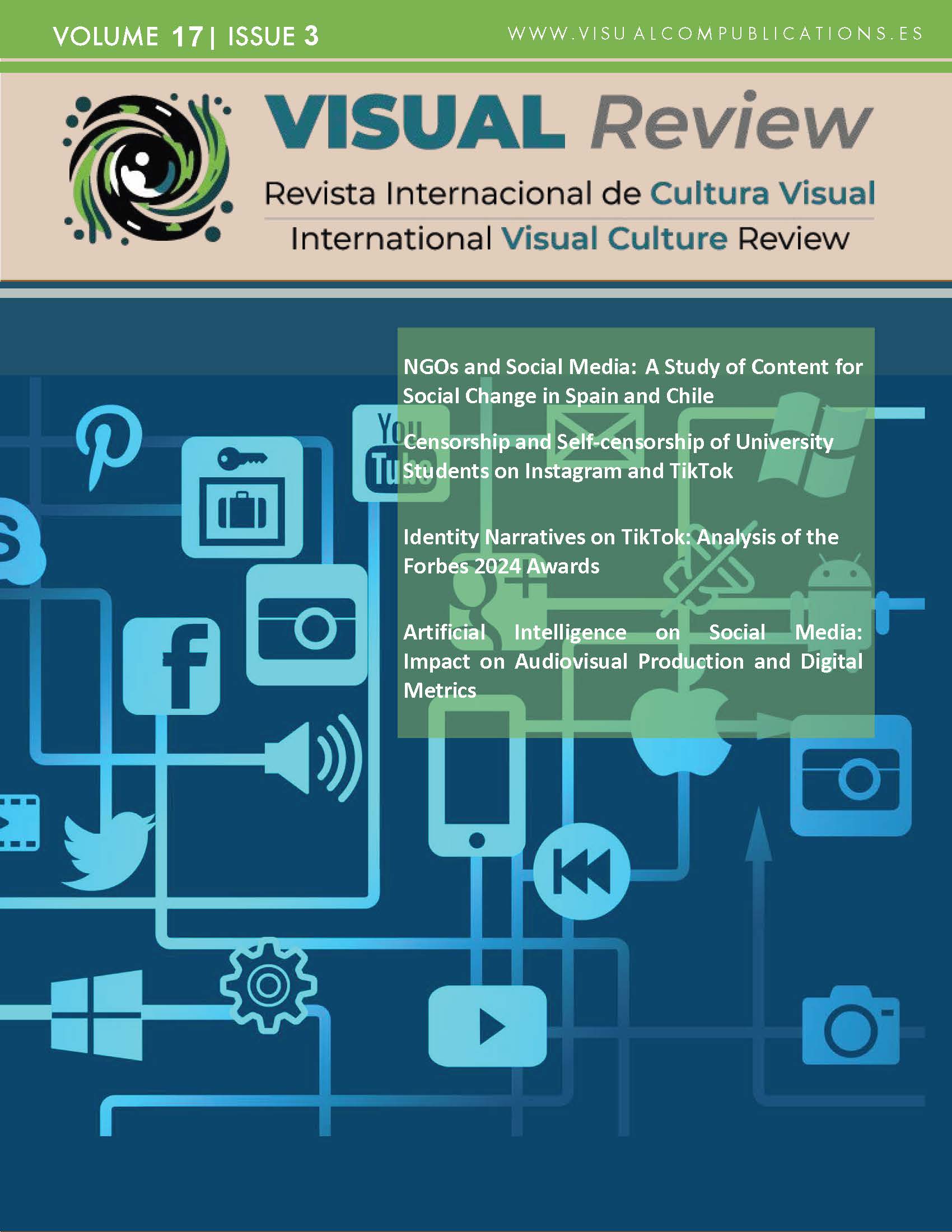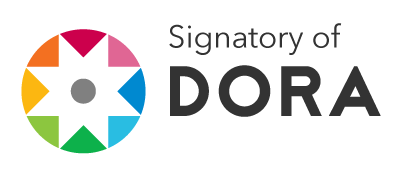NGOs and Social Media
A Study of Content for Social Change in Spain and Chile
DOI:
https://doi.org/10.62161/revvisual.v17.5788Keywords:
NGOs, Non-Profit Organizations, Activism, Social Media, Social Awareness, Visual ActivismAbstract
Comparative study of the publications on Facebook, Instagram, Youtube, X and Tiktok of NGOs in Chile and Spain to find out whether their profiles help to promote activism in social issues and what type of visual content they use. The methodology was mixed with a quantitative-qualitative approach: analysis of 3,611 publications from 20 organisations complemented by 12 in-depth interviews with the organisations' communication managers. The results show that photos are the most used content in all the networks, but only two Spanish NGOs use the networks with an activist objective.
Downloads
Global Statistics ℹ️
|
391
Views
|
242
Downloads
|
|
633
Total
|
|
References
Abbas, L., Fahmy, S. S., Ayad, S., Ibrahim, M., & Ali, A. H. (2022). TikTok intifada: Analyzing social media activism among youth. Online media and global communication, 1(2), 287-314. https://doi.org/10.1515/omgc-2022-0014 DOI: https://doi.org/10.1515/omgc-2022-0014
Alonso-González, M. (2021). Activismo social femenino en la esfera pública digital. Vivat Academia, 133-156. http://doi.org/10.15178/va.2021.154.e1239 DOI: https://doi.org/10.15178/va.2021.154.e1239
Arroyo-Almaraz, I., & Mendoza, S. C. (2018). Los community managers de las ONGD. Estudio de percepciones y usos de las redes sociales. Revista ICONO 14. Revista científica de Comunicación y Tecnologías emergentes, 16(2), 121-142. https://doi.org/10.7195/ri14.v16i2.1189 DOI: https://doi.org/10.7195/ri14.v16i2.1189
Bai, Q., Dan, Q., Mu, Z., & Yang, M. (2019). A systematic review of emoji: Current research and future perspectives. Frontiers in Psychology, 10, 2221. https://doi.org/10.3389/ fpsyg.2019.02221 DOI: https://doi.org/10.3389/fpsyg.2019.02221
Bergman JN, Buxton RT, Lin H-Y, Lenda M, Attinello K, Hajdasz AC, Rivest SA, Tran Nguyen T, Cooke SJ, & Bennett JR. 2022. Evaluating the benefits and risks of social media for wildlife conservation. Facets 7: 360–397.https:// doi:10.1139/facets2021-0112 DOI: https://doi.org/10.1139/facets-2021-0112
Bilgin, Y., & Kethüda, Ö. (2022). Charity social media marketing and its influence on charity brand image, brand trust, and donation intention. VOLUNTAS: International Journal of Voluntary and Nonprofit Organizations, 33(5), 1091-1102. https://doi.org/10.1007/s11266-021-00426-7 DOI: https://doi.org/10.1007/s11266-021-00426-7
Borah, P. (2009). Comparing visual framing in newspapers: Hurricane Katrina versus tsunami. Newspaper Research Journal, 30(1), 50–57. https://doi.org/10.1177/073953290903000106 DOI: https://doi.org/10.1177/073953290903000106
Brunner, B. R. (2008). Listening, communication & trust: Practitioners’ perspectives of business/organizational relationships. International Journal of Listening, 22, 73–82. https://doi:10.1080/10904010701808482 DOI: https://doi.org/10.1080/10904010701808482
Buitrago, Á., & Martín García, A. (2021). Community managers en Instagram: la labor de las Relaciones Públicas de las marcas en el universo de las redes sociales. Sphera Publica, 2(21). https://sphera.ucam.edu/index.php/sphera-01/article/view/427
Capriotti, P., Zeler, I. & Camilleri, M.A. (2021). Corporate Communication Through Social Networks: The Identification of the Key Dimensions for Dialogic Communication. En M.A. Camilleri, (Ed.) Strategic Corporate Communication in the Digital Age (33-51). Emerald Publishing Limited, Leeds. https://doi.org/10.1108/978-1-80071-264-520211003 DOI: https://doi.org/10.1108/978-1-80071-264-520211003
Claro, C., Ferruz-González , S. A., & Catenacci, J. (2023). Redes sociales y tercer sector: análisis del uso de Facebook e Instagram en 50 ONG de España y Chile. Revista Latina De Comunicación Social, (82), 1–21. https://doi.org/10.4185/rlcs-2024-2197 DOI: https://doi.org/10.4185/rlcs-2024-2197
Centro UC Políticas Públicas (2023). Mapa de las organizaciones de la Sociedad Civil en Chile. Politicas Públicas. https://bit.ly/3PQUf7e
Chen, Y., Sherren, K., Smit, M., & Lee, K. Y. (2023). Using social media images as data in social science research. New Media & Society, 25(4), 849-871. https://doi.org/10.1177/14614448211038761 DOI: https://doi.org/10.1177/14614448211038761
Coordinadora de Organizaciones para el Desarrollo (2023). Informe del Sector de las ONGD 2023. Coordinadoraongd.org. https://bit.ly/4avjkxS
Dhanesh, G. S., & Rahman, N. (2021). Visual communication and public relations: Visual frame building strategies in war and conflict stories. Public Relations Review, 47(1), 102003. https://doi.org/10.1016/j.pubrev.2020.102003 DOI: https://doi.org/10.1016/j.pubrev.2020.102003
Dumitrica, D. (2021). Integrating Social Media in NGO Strategic Communication: Lessons From Dutch NGOs' Communication Practices. In Global perspectives on ngo communication for social change (pp. 73-89). Routledge. DOI: https://doi.org/10.4324/9781003188636-6
Enosh, G., Tzafrir, S. S., y Stolovy, T. (2014). The development of client violence questionnaire (CVQ). Journal of Mixed Methods Research, 9(3), 273–290. https://doi.org/10.1177/1558689814525263 DOI: https://doi.org/10.1177/1558689814525263
Etter, M., & Albu, O. B. (2021). Activists in the dark: Social media algorithms and collective action in two social movement organizations. Organization, 28(1), 68-91. https://doi.org/10.1177/1350508420961532 DOI: https://doi.org/10.1177/1350508420961532
Galiano-Coronil, A., & Mier Terán-Franco, J. J. (2019). The use of social digital networks by NGDO from a social marketing perspective. Social Sciences, 8(6), 192. https://doi.org/10.3390/socsci8060192 DOI: https://doi.org/10.3390/socsci8060192
García Galera, C., Fernández Muñoz, C. y del Olmo Barbero, J. (2018). La comunicación del tercer sector y el compromiso de los jóvenes en la era digital. Zer, (44), 155-174. https://doi.org/10.1387/zer.19164 DOI: https://doi.org/10.1387/zer.19164
Grunig, J. E., & Hunt, T. T. (1984). Managing public relations. Holt, Rinehart and Winston.
Fahmy, S., Bock, M., & Wanta, W. (2014). Visual communication theory and research: A mass communication perspective. Springer. DOI: https://doi.org/10.1057/9781137362155
Jurgenson N. (2019) The Social Photo: On Photography and Social Media. Verso.
Kent, M. L., & Taylor, M. (2021). Fostering dialogic engagement: Toward an architecture of social media for social change. Social Media+ Society, 7(1). https://doi.org/10.1177/2056305120984462 DOI: https://doi.org/10.1177/2056305120984462
Lapierre Acevedo, M. (2023). Activismo digital de mujeres con discapacidad en Instagram: análisis de tres casos en Chile. Cuadernos. info, (54), 225-246. http://dx.doi.org/10.7764/cdi.54.51207 DOI: https://doi.org/10.7764/cdi.54.51207
Lee, S. Y., Lim, J. R., & Shi, D. (2024). Visually framing disasters: Humanitarian aid organizations’ use of visuals on social media. Journalism & Mass Communication Quarterly, 101(3), 749-773. https://doi.org/10.1177/10776990221081046 DOI: https://doi.org/10.1177/10776990221081046
León, B., Negredo, S., & Erviti, M. C. (2022). Social Engagement with climate change: principles for effective visual representation on social media. Climate Policy, 22(8), 976-992. https://doi.org/10.1080/14693062.2022.2077292 DOI: https://doi.org/10.1080/14693062.2022.2077292
Li, Y., Bernard, J. G., & Luczak-Roesch, M. (2021). Beyond clicktivism: What makes digitally native activism effective? An exploration of the sleeping giants movement. Social media + Society, 7(3). https://doi.org/10.1177/20563051211035357 DOI: https://doi.org/10.1177/20563051211035357
López-García, G., y Valera Ordaz L. (2024). La esfera pública post mediática. Debates. Revista de Cultura, Poder y Sociedad, 138(1), 98–114. https://doi.org/10.28939/iam.debats-138-1.7 DOI: https://doi.org/10.28939/iam.debats-138-1.7
Ma, L., & Zhang, Y. (2022). Three social-mediated publics in digital activism: A network perspective of social media public segmentation. Social Media+ Society, 8(2). https://doi.org/10.1177/20563051221094775 DOI: https://doi.org/10.1177/20563051221094775
Maxwell, J. A. (2016). Expanding the history and range of mixed methods research. Journal of Mixed Methods Research, 10(1), 12–27. https://doi.org/10.1177/1558689815571132 DOI: https://doi.org/10.1177/1558689815571132
Millaleo, S. & Velasco, P. (2013). Activismo Digital en Chile. Fundación Democracia Desarrollo. https://repositorio.uchile.cl/bitstream/handle/2250/129857/Activismo-Digital-en-Chile.pdf
Mut-Camacho, M., & García-Huguet, L. (2023). Presencia y objetivos perseguidos del uso de las redes sociales por parte de ONGD españolas de mujeres. Comunicación y Tercer Sector de Acción Social. Miscelánea sobre la reputación de las ONG en España y Latinoamérica, 269-293. Tirant Lo Blanch.
Place, K. R., & Ciszek, E. (2021). Troubling dialogue and digital media: A subaltern critique. Social Media+ Society, 7(1). https://doi.org/10.1177/2056305120984449 DOI: https://doi.org/10.1177/2056305120984449
Salamon, L.M. y Anheier, H.K. (1997). Defining the nonprofit sector: A cross-national analysis. Manchester University Press.
Sidorenko-Bautista, P. , Cabezuelo-Lorenzo, F., & de la Casa, J. M. H. (2021). Instagram como herramienta digital para la comunicación y divulgación científica: el caso mexicano de @pictoline. Chasqui: Revista latinoamericana de comunicación, (147), 143-162. https://doi.org/10.16921/chasqui.v1i147.4472 DOI: https://doi.org/10.16921/chasqui.v1i147.4472
Statista (2024). Distribución porcentual de los usuarios de Facebook en España en 2024, por edad. Statista. https://bit.ly/42vB0rg
Suárez, J. R., Neches, L. M., & Olaizola, J. H. (2021). Investigación en red, nuevos lenguajes y simbologías del activismo digital: Una revisión sistemática. Comunicar: Revista Científica de Comunicación y Educación, (68), 47-58. https://www.revistacomunicar.com/html/68/es/68-2021-04.html
Urquía, I. (2024). Spanish Universities on TikTok: The Effectiveness of Trends and Challenges in Generating Engagement. VISUAL REVIEW. International Visual Culture Review Revista Internacional De Cultura Visual, 16(8), 15–27. https://doi.org/10.62161/revvisual.v16.5362 DOI: https://doi.org/10.62161/revvisual.v16.5362
We are Social (2024). Informe Digital 2024. Disponible en: https://wearesocial.com/es/blog/2024/01/digital-2024/
Willoughby, J. F., & Liu, S. (2018). Do pictures help tell the story? An experimental test of narrative and emojis in a health text message intervention. Computers in Human Behavior, 79, 75– 82. https://doi.org/10.1016/j.chb.2017.10.031 DOI: https://doi.org/10.1016/j.chb.2017.10.031
Yang, G. (2016). Narrative agency in hashtag activism: The case of #BlackLivesMatter. Media and Communication, 4(4), 13. https://doi.org/10.17645/mac.v4i4.692 DOI: https://doi.org/10.17645/mac.v4i4.692
Downloads
Published
How to Cite
Issue
Section
License
Copyright (c) 2025 Authors retain copyright and transfer to the journal the right of first publication and publishing rights

This work is licensed under a Creative Commons Attribution-NoDerivatives 4.0 International License.
Those authors who publish in this journal accept the following terms:
-
Authors retain copyright.
-
Authors transfer to the journal the right of first publication. The journal also owns the publishing rights.
-
All published contents are governed by an Attribution-NoDerivatives 4.0 International License.
Access the informative version and legal text of the license. By virtue of this, third parties are allowed to use what is published as long as they mention the authorship of the work and the first publication in this journal. If you transform the material, you may not distribute the modified work. -
Authors may make other independent and additional contractual arrangements for non-exclusive distribution of the version of the article published in this journal (e.g., inclusion in an institutional repository or publication in a book) as long as they clearly indicate that the work was first published in this journal.
- Authors are allowed and recommended to publish their work on the Internet (for example on institutional and personal websites), following the publication of, and referencing the journal, as this could lead to constructive exchanges and a more extensive and quick circulation of published works (see The Effect of Open Access).













